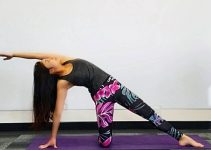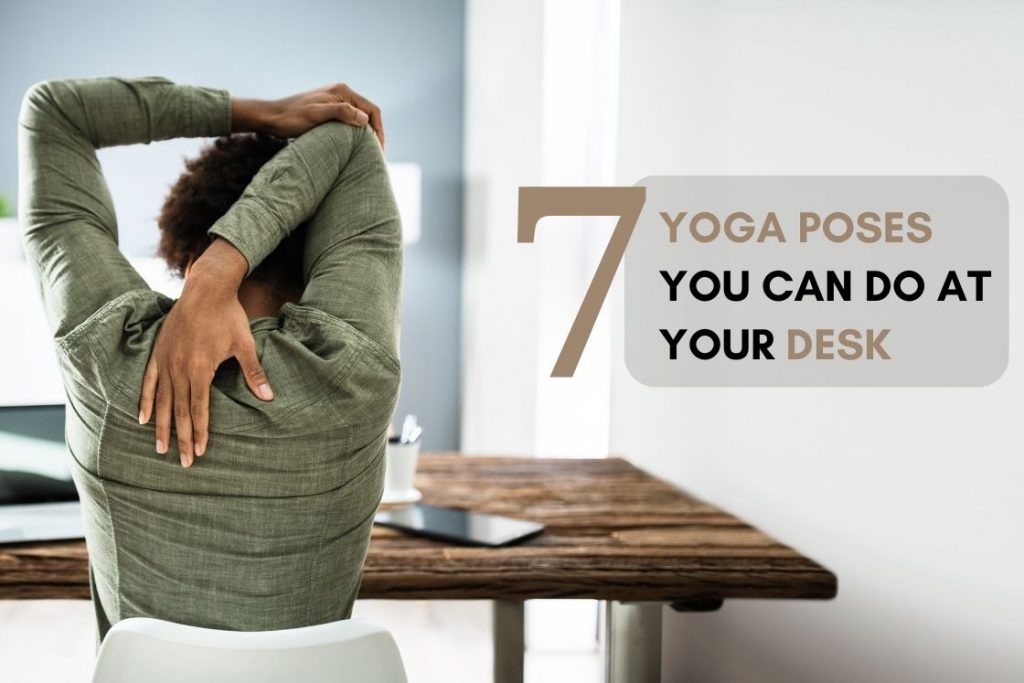
Too much of the day is spent by many of us staring at computer displays while we work at our desks. Working sitting at a desk job makes our backs hunched, our necks pushed forward, and our shoulders slumped forwards. This leads to neck pains, back pains, stiff shoulders, and other types of body aches.
People who work professions that require them to spend long periods seated in front of a computer should take more stretch breaks. This will encourage blood circulation to your legs, back, and arms and also give some room for the muscles to flex.
Even if you practice yoga once a day, you should include some stretching during your work hours. For this purpose, desk yoga is a quick and easy technique to relax.
What is Desk Yoga?
There are some yoga poses which can be effectively done while sitting in your chair, even in between working hours. Desk yoga comprises some modified yoga stretches that help you stay active and engaged all through the workday.
Desk yoga is to relax, unwind and stretch while working from home or the office. It can be done easily without a yoga mat and no yoga props at all. It can be 5 to 10 minutes of stretching when you get free time in between your working hours.
The exercises of desk yoga are minor variations of normal yoga poses that have been customized to suit the small space of your desk or workstation.
You will find that doing desk yoga exercises and stretching for even 2 minutes will enhance your productivity, energize your mind and body, reduce any muscular tension and mental stress and improve overall mood.
Here are some of the most common desk yoga stretches.
1. Seated Cat-cow pose
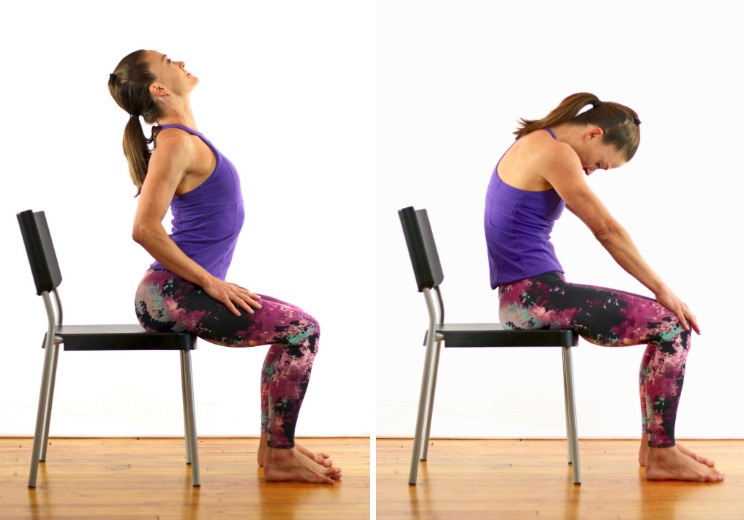
The traditional cat-cow pose is incredibly rejuvenating. It targets the spine by upwards and downward flexion of the back. This movement stretches the back muscles and spine while removing any stiffness in the shoulder and neck and opening the chest.
The same benefits can be gained when you perform the cat-cow stretch sitting upright at your desk. The back and front movement will prompt your chest to open paving way for enhanced lung capacity. It will encourage flexibility of the shoulder and reduce pain in the back and neck.
Also read: 7 Heart Opening Yoga Poses to Relieve Chest and Shoulder Pain
Steps to perform
- Sit up straight at the front edge of your chair with your feet spread hip-width apart and planted firmly on the ground. Your knees and ankles should be in a straight line and your toes should point forward.
- Placing your palms on your thighs or knees, preferably with palms facing down.
- Inhale and raise your head up and backward while taking a deep breath. Extend your chest outwards and push your shoulder back.
- Create an arch in your lower back by squeezing your shoulder blades together and pushing them downward. This is the cow pose.
- Exhale and draw your upper body inwards, beginning with your lower back, abdomen, and chest.
- Your head should tilt down, your shoulders should be rounded, and your chin should rest on your chest. This is the cat pose.
- Perform this flexion 8–10 times at your desk.
2. Seated Spinal Twist
Another great stretch you can do sitting on your desk is spinal twisting. This pose will stretch your back muscles, which will ease stress and soreness. Furthermore, it stimulates the organs in your abdomen. The twist will aid in relieving any ache or pain in the lower back, which is a common complaint with working professionals. The entire upper body will also be stretched regularly.
It’s important to remember that the muscles, not the joints, are the primary focus of this desk yoga stretch. Hence you should avoid attempting to pop your back. Don’t stretch past your level of comfort and keep your spine straight.
Steps to perform
Depending on the type of chair you use to sit, this pose can be performed in two ways.
Version 1 – Chair with no arms
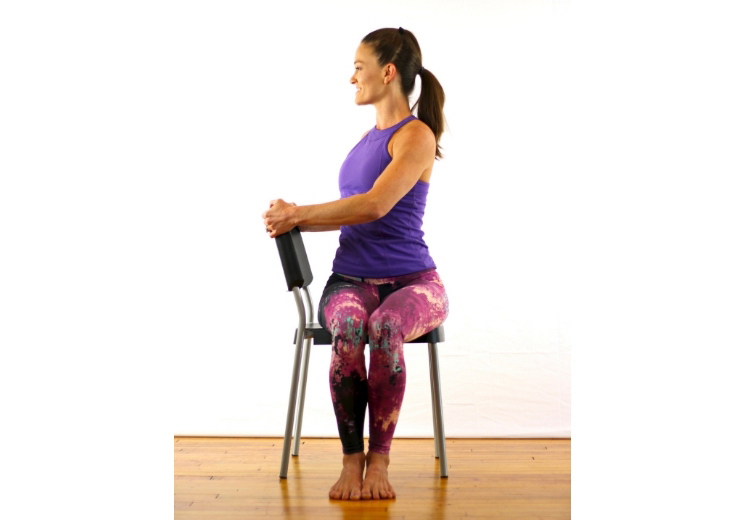
- Sit sideways on your chair such that your right side is facing the back of the chair.
- Keep your feet firmly planted on the floor with a straight back. Align your head with the spine.
- Turn your upper body, along with the head, towards the right to face the back of the chair. Hold the back of the chair with both hands.
- Stay in this position for 10 seconds or as long as you want and come back to the original position.
- Perform the twist 8-10 times and switch sides.
Version 2 – Chair with arms
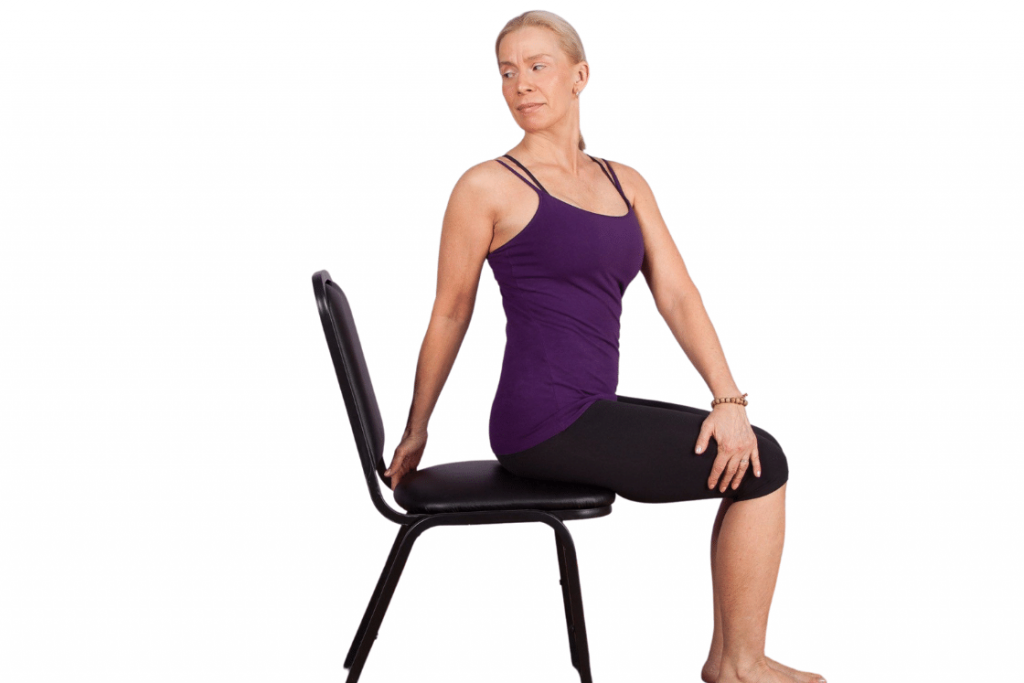
- Sit up straight at the front edge of your chair with your feet planted firmly on the ground.
- Keeping your lower body still, twist your upper body, along with the head, to the right while moving your right hand to hold the back of the chair. Your left hand should move to be placed on the right knee or the right arm of the chair.
- Stay in this position for 10 seconds or as long as you want and come back to the original position.
- Perform the twist 8-10 times and switch sides.
Also read: 8 Chair Yoga Poses Seniors Can Do Easily At Home
3. Seated Crescent Moon Pose
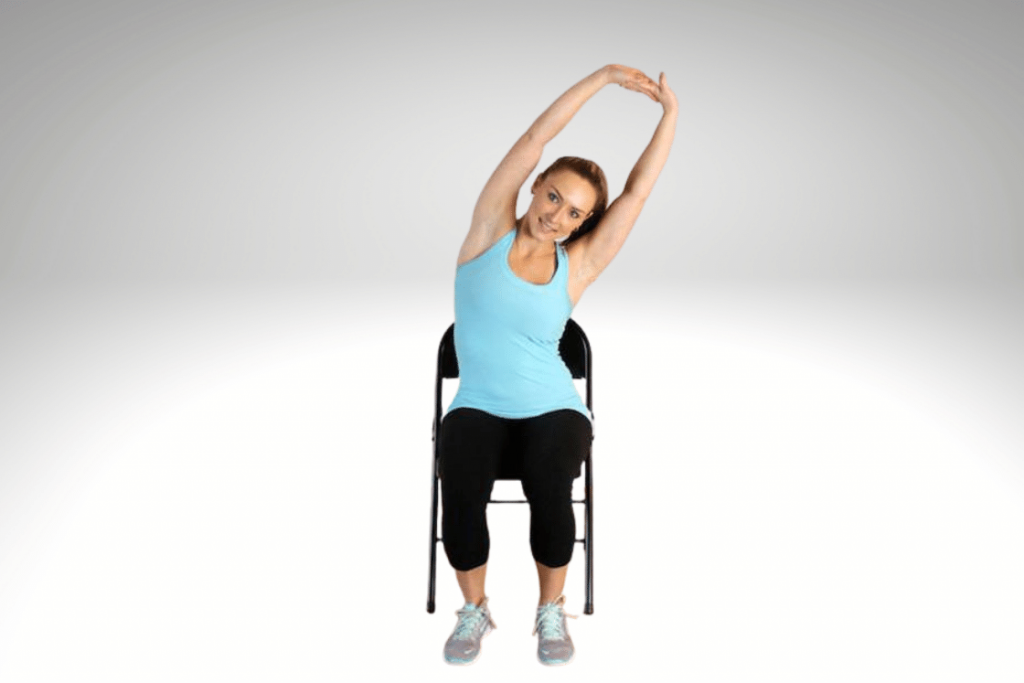
Usually, the side muscles of the body are often neglected while sitting at chair for long hours. Seated crescent moon pose is extremely beneficial for the lateral muscles.
By stretching sideways, you encourage the muscles of your torso, arms, and back to release any kinks or stress accumulated with prolonged sitting at work. This is also a great way to lengthen and stretch your vertebral column.
Steps to perform
- Sit up straight at the front edge of your chair with your feet planted firmly on the ground.
- Extend your arms overhead and join the palms.
- Bend to the right side slowly and gently. Go as far as your flexibility allows.
- Hold for 5-7 seconds and come back to the original position.
- Bend to the left side slowly, hold for 5-7 seconds and come back to the original position.
- Repeat this process as many times as you want.
4. Chair Pigeon Pose
This pigeon pose variation for desk yoga is a great hip and glute stretch that may loosen up tension and improve hip openness, flexibility, and mobility. While opening the hips and chest, this pose also assists us in regaining the balance we occasionally lose while seated in chairs. It is especially beneficial if you want to avoid problems like sciatica and back pain
Steps to perform
- Sit up straight at the front edge of your chair with your feet planted firmly on the ground.
- Lift your right foot and place the ankle on the left knee. Hold the knee and foot of the right leg with your hands to maintain leg alignment.
- For enhanced stretch to the glutes, lower back, and hamstrings, bend forward slightly.
- Hold this position for 5-7 seconds and lower your leg gently.
- Perform the same with your left leg.
- Repeat the process at least 5 times.
5. Half Downward Facing Dog
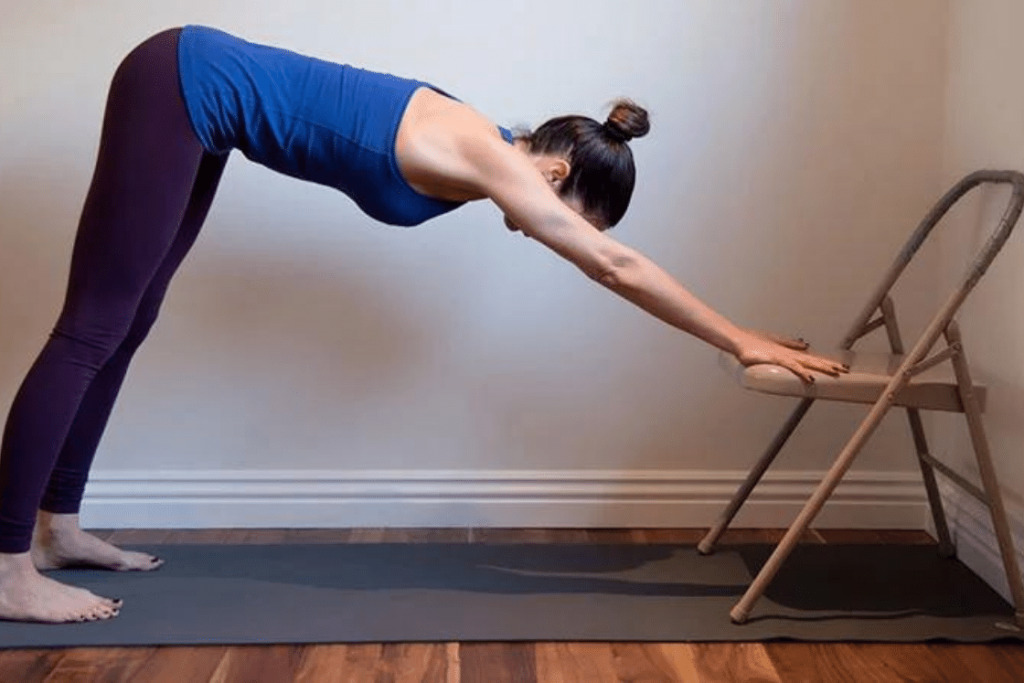
Downward facing dog or Adho mukha svanasana is a very popular pose in yoga.
This desk yoga variation of downward dog pose helps to remove stiffness in your shoulders, back and hips. It is helpful in extensively stretching the entire back while enhancing the flexibility of the hips. Performing this pose is a great way to counter the hunched-over position you stay in all day.
The best part about this variation is that you can perform this pose even while sitting on your chair, especially if it is a chair with wheels.
Also Read: The Best Yin Yoga Sequence for Tight Hips
Steps to perform
- Stand at your desk with your hands placed at the edge of the table.
- Take a few steps back while your hands are still holding the table.
- Go as far back as you want for the stretch to be intensive.
- Hold your position for at least 5 seconds.
- Slowly come back to the original position and stand straight.
If you have chairs with wheels, the entire process will be the same except you will move your chair back at the same pace as you would while standing.
Additionally, instead of holding the table edge, you can hold the back of the chair. However, the chair should not have wheels as it will not give your the stability to hold the pose.
6. Seated Forward Bend
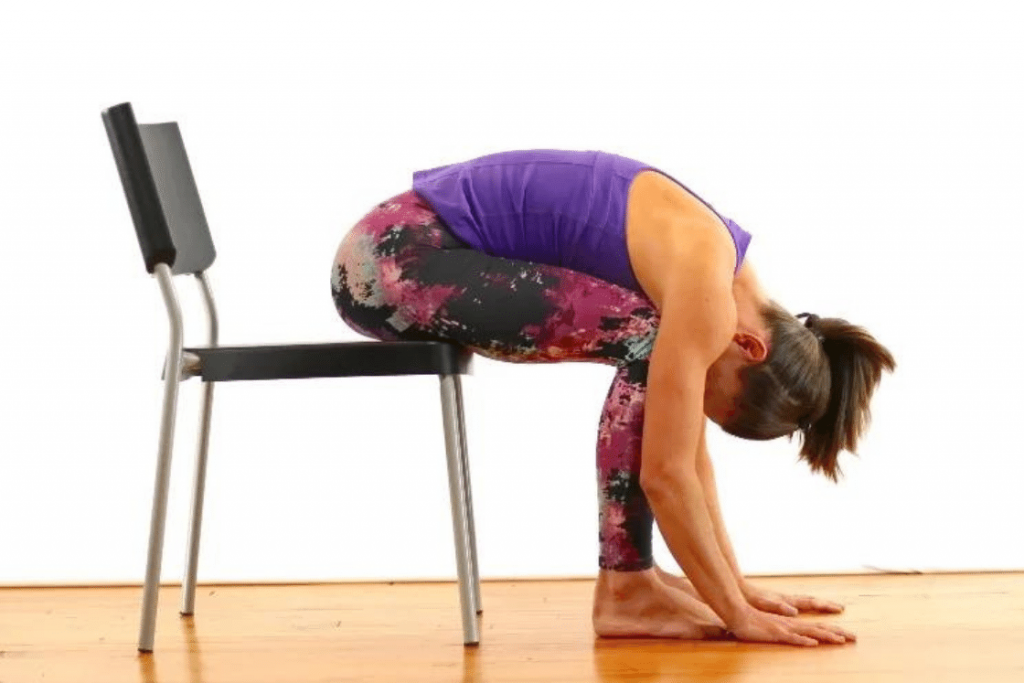
This desk yoga pose is great to stretch your entire back.
Seated forward bend assists to release the lower back, shoulders, neck, and hips. It is an effective approach to quickly nourish and engage the muscles, nerves, and joints of the upper body to relieve stiffness.
After a long of sitting, doing chair seated forward bend make one feel lighter and calm as the body circulates toward the head and eliminates all of the tension at the base of the neck.
For this pose, make sure your chair doesn’t have wheels as you would not want your chair to slide as you fold.
Steps to perform
- Sit up straight at the front edge of your chair with your feet spread hip-width apart and planted firmly on the ground. Your knees and ankles should be in a straight line and your toes should point forward.
- Place your hands on your knees, palms facing down.
- From your hips, slowly start to bend forward while sliding your hands down as well. Go as far as you can go.
- Let your head and arms hang freely and stay in this position for at least 3 seconds or as long as you can.
- Gently come back up to the original position and relax.
7. Wrist and finger stretch
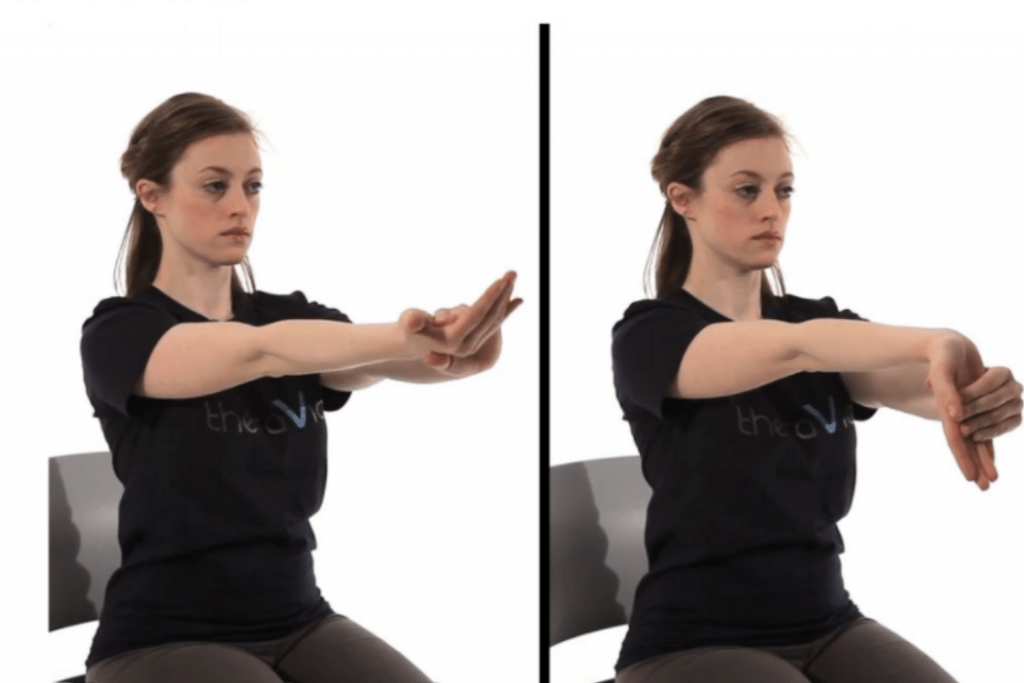
While it may not be a yoga pose, stretching your wrists and fingers frequently at work is essential to relax your hands.
By utilizing a keyboard and writing equipment repeatedly, you run the risk of straining and tiring out your wrists. Exercises involving wrist flexion and extension may be able to lessen the stress that comes with this kind of occupation.
To enhance the blood flow, it is important to perform hand yoga stretches frequently throughout the day.
Also Read: 8 Hand Yoga Stretches for Carpal Tunnel Syndrome Pain Relieve
Steps to perform
- To stretch your fingers, extend your right arm in front of you at shoulder level.
- Keep your hand vertically straight so that the fingers are pointed up.
- Hold your right-hand fingers with your left hand and pull them back. Keep pulling for 5 seconds and release.
- Do this exercise in quick succession 8-10 times. Repeat with the other hand.
- For wrist stretch, stand near the table.
- Rotate your wrists such that your fingers are pointed downwards and place your hands on the edge of the table.
- Straighten your arms and lean away from your desk, flattening your palms as much as you can. Hold this position for 3-5 seconds and come back to the original position.
- Relax for a few seconds and repeat the process. Do this 8-10 times.
Conclusion
These exercises are accessible to all employees, regardless of yoga proficiency. Many stretches may be performed at the desk with little to no space required. To counteract fatigue, stress, and stiffness and enhance joint fluid secretions and posture, take breaks to stretch and move your body. While sitting at your desk, make an effort to add 5-minute stretching or activity breaks every hour.
